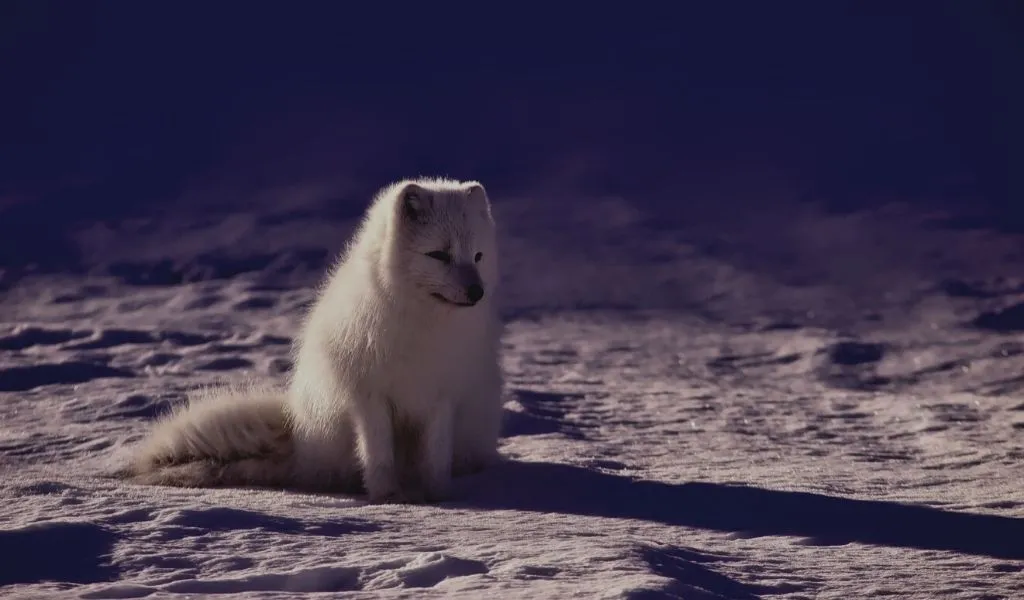Most foxes are nocturnal, especially in urban areas, so you’ll often be surprised to spot one during the day when they tend to sleep. However, what about the arctic fox which inhabits regions with fewer dangers during the day? Are arctic foxes nocturnal or diurnal?
Arctic foxes are mainly nocturnal although they are flexible and well adapted to both day and night. Behavior can vary between populations based on food scarcity, predators, competitors, and human disturbance. However, day and night are often irrelevant in the arctic which experiences polar nights and midnight sun.
Keep reading to find out more about the nocturnal and diurnal behavior of arctic foxes and how it differs between regions.
Why Are Arctic Foxes Nocturnal?
Arctic foxes are mainly nocturnal which means they are more active at night. However, they are very flexible and can adapt their behavior according to their needs1 (source: Mammalian Species, A.M. Audet, C.B. Robbins, S. Larivière, Vol 713, 2002).
There is a lot of variation between different sub-populations of the arctic fox. For example, those in Svalbard (a Norwegian group of islands in the arctic) have been reported to be mostly nocturnal whereas observations in Russia have been reported them to be equally active during the day and at night2 (source: Polar Research, E. Fugleia et al., Vol 36, No. 10, 2017).
There are several factors that contribute to the activity of arctic foxes at night and during the day, these include:
- Food Availability – When food is scarce, foxes may need to hunt at night and during the day to ensure enough food to survive.
- Predators/Competitors – The presence of arctic fox predators or competitors may limit their ability to hunt during the day. For example, the presence of golden eagles in Varanger, Norway, forces arctic foxes here to be more nocturnal3 (source: Polar Research, E. Fugleia et al., Vol 36, No. 10, 2017).
- Human Disturbance – There have been observed differences in arctic fox behavior in areas with high levels of human disturbance. More on this below.
However, all being said, the terms day and night have little meaning in the Arctic for large parts of the year.
This is because regions above the arctic circle can experience 24 hours of darkness during winter (known as polar nights) and 24 hours of sunlight during summer (known as midnight sun).
How Humans Impact Arctic Foxes Nocturnal Behavior
As touched on above, arctic foxes behave differently in areas where there are high levels of human disturbance. However, we can’t objectively say this makes them more or less nocturnal because it depends on the situation.
Where human disturbances take place within the general range of the arctic fox, it is likely to make them more nocturnal in an effort to avoid human encounters. This was the case around snowmobile trails in a study in Alaska4 (source: The Journal of Wildlife Management, L.E. Eberhardt et al., Vol. 46, No. 1, 1982).
However, where human disturbance is near their dens or breeding sites, it’s likely to have the opposite effect, making them more active during the day as they attempt to protect their young from the perceived human threat5 (source: Global Ecology and Conservation, M. Larm, K. Norén, and A. Angerbjörn, Vol 27, 2021).
Do Arctic Foxes Sleep at Night?
No, most studies and observations suggest that arctic foxes either sleep mostly during the day or split their sleep equally between day and night. There is no evidence of any arctic foxes that only sleep at night.
A study of the arctic fox’s physiological adaptations showed that they did not have circadian rhythms in body temperature and heart rate6 (source: Physiological adaptations of the Arctic fox to High Arctic conditions. E. Fuglei, 2000), this essentially means they do not have a dominant body clock. Yet despite this, they do still tend to be active at night.
During parts of the year, there are no days and nights in the arctic because the sunlight and darkness can last for more than 24 hours. On the arctic circle, this can last for a few days, but as you head further north towards the north pole, polar nights and midnight sun can last for weeks or months at a time.
This is why arctic foxes have evolved traits to help them hunt in light and darkness otherwise they would go without food during these periods.
What Do Arctic Foxes Do During the Day?
In most places, arctic foxes will sleep in their dens during the day.
Arctic foxes build dens which are like large mazes with many escape routes, they use these to avoid and evade predators. These dens are usually on nutrient-rich soil and vegetation which has been shown to attract other arctic animals, including lemmings, the main prey of an arctic fox7 (source: The Wildlife Society).
However, in regions where they are awake during the day, they will spend their time hunting for food.
Unlike kit foxes and red foxes which have vision better suited to dim light, arctic foxes are well adapted for both day and night vision8 (source: The American Naturalist, J.L. Kavanau, and J. Ramos, Vol 109, No. 968, 1975).
How Do Arctic Foxes Hunt?
Arctic foxes have different diets depending upon where they live. Those inland eat a diet of lemmings and other small rodents, whereas those in coastal areas will eat seabirds, fish, and marine invertebrates.
For inland arctic foxes, their main food source, lemmings, are both nocturnal and diurnal, meaning they are active at night and during the day9 (source: Wikipedia). So the foxes can hunt whenever they like.
However, some of their prey, such as caribou (reindeer) are diurnal, but arctic foxes have been reported to return to their carcasses at night.
Arctic foxes are well camouflaged with a coat that changes color with the seasons to blend into the white snow in winter and the earthy tones of the tundra in summer when it melts. Their main hunting tactic is to use their camouflage to sneak up on their prey without being seen.
Arctic foxes tend to use their hearing more than their eyes for hunting which is why they can be successful at any time of day. They can hear the high-pitched sound that rodents make as they scuffle through the grass or snow. Once it is sure of the prey’s location, the fox will jump up in the air and dive its head into the snow to catch them10 (source: How do arctic foxes hunt in the snow?, Colarado State University, Feb 2021).
How Many Hours Do Arctic Foxes Sleep?
Arctic foxes will sleep for anywhere between a few minutes and several hours at a time and they may do this multiple times throughout the day11 (source: Ecology of the Arctic Fox, H. Fine, 1980). They tend to sleep in a curled-up position to conserve body heat.
They are very light sleepers and can quickly awake to respond to threats such as approaching predators.
Young pups might spend up to 50% of their time resting although this will decrease as they get older and are required to hunt for their own food12 (source: Mammalian Species, A.M. Audet, C.B. Robbins, S. Larivière, Vol 713, 2002).




![Read more about the article 17 Facts About the Arctic Fox [Some May Surprise You]](https://polarguidebook.com/wp-content/uploads/2021/09/Facts-about-arctic-foxes-300x176.jpg)
